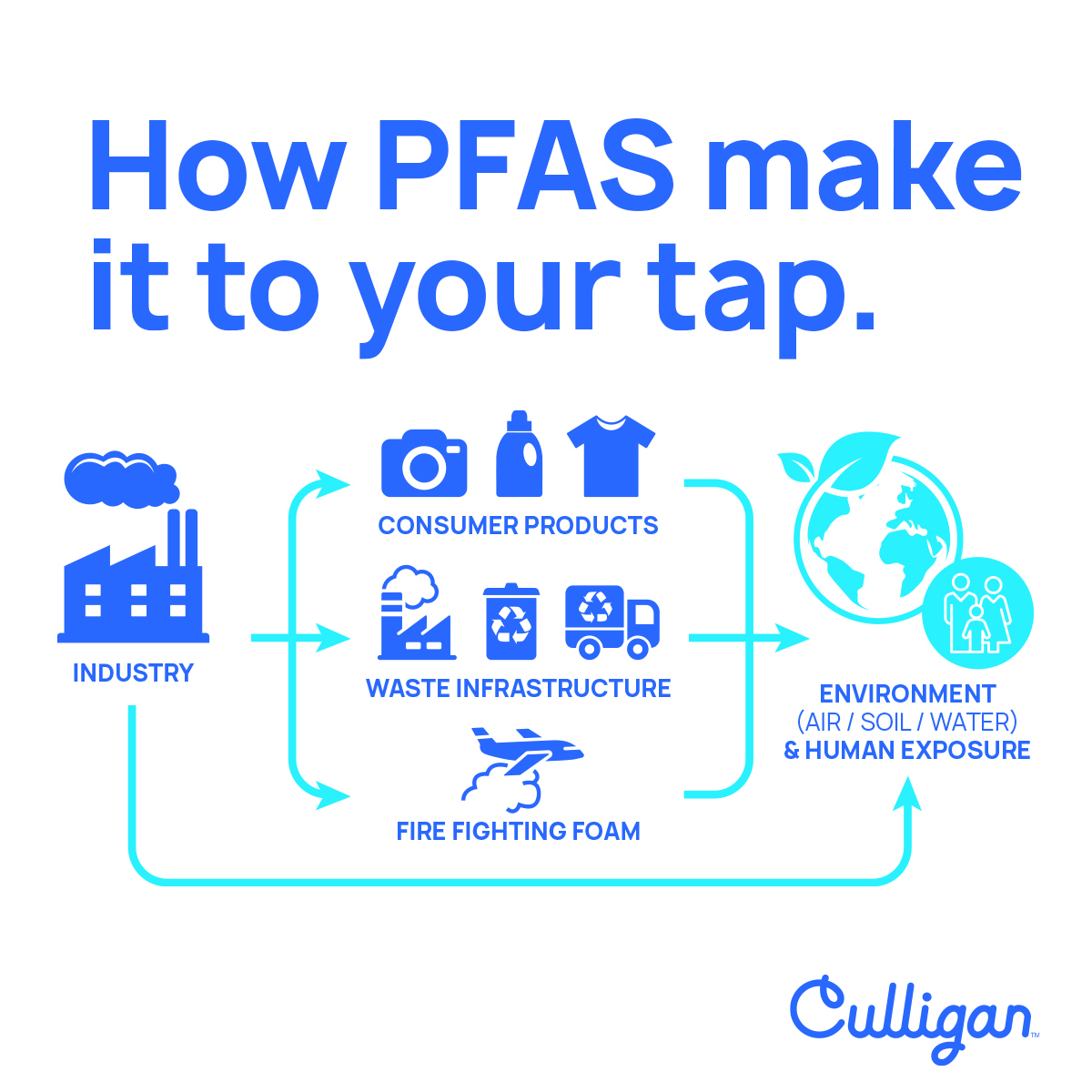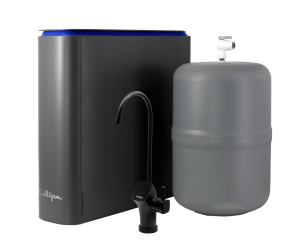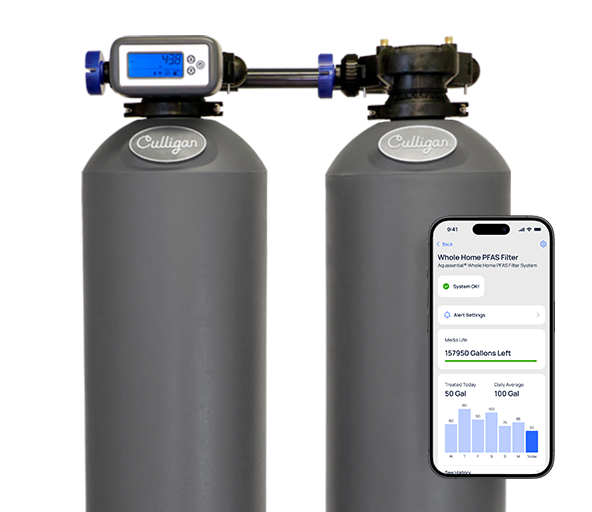Are There PFAS Forever Chemicals In Clearwater, Largo, Port Richey, and St. Petersburg Drinking Water?
PFAS, otherwise known as "Forever Chemicals", are often found in the water sources where Clearwater, Largo, Port Richey, and St. Petersburg obtain their water. The question is, how much, and is it too much? The current results of the EPA study show results that border the current proposed maximum contaminant levels for regulatory standards.
Is My Water Contaminated With PFAS?
Water quality reports from Clearwater, Largo, Port Richey, and St. Petersburg does not report on PFAS levels.This suggests that PFAS were not detected or not tested for in the most recent reporting period. Additionally, The EWG's Tap Water Database does not show PFAS detections in these area's water systems. However, this does not mean that PFAS aren't existing in the water supply, as a recent report indicated that 8.9 million Floridians have PFAS in their drinking water, and a significant number of water systems across the state have detected these chemicals.
Certain areas have a higher propensity for PFAS-contaminated water. For example, if you live near an airport or a firefighter training facility where many of these chemicals have historically been used, there’s a good chance they’re still found in relatively high concentrations.Areas around manufacturing centers also commonly have elevated levels of PFAS, since they were used in the production of carpet, food packaging and production, and many other consumer goods.
How PFAS Forever Chemicals Were Introduced
It started in the early 1940s, when water and heat-resistant chemicals containing per- and polyfluoroalkyl substances were engineered to help create non-stick products (Teflon), fire retardants, and other common consumer goods.What wasn’t understood at the time, however, was that Teflon and other products using PFAS wouldn’t naturally decay in nature–or the human body.

Why Is My Drinking Water Contaminated With PFAS Forever Chemicals In The Gulf Coast Area of Florida?
When it comes to PFAS-contaminated water, the situation can be particularly relevant to residents in the Gulf Coast area. Certain areas are more susceptible to elevated levels of PFAS due to historical usage of these chemicals in various industrial and commercial activities.
Living near specific sites, such as airports or firefighter training facilities, could put residents at a higher risk of encountering water with elevated PFAS concentrations. These sites historically utilized PFAS-containing foams for firefighting exercises and emergency response drills, which could have seeped into the ground and eventually reached the water supply. As such, individuals residing near these locations might be concerned about the levels of PFAS in their tap water.
Manufacturing facilities of all kinds are also to blame for PFAS being found in water supplies. Over time, these chemicals might have entered the local water sources, potentially leading to higher concentrations in certain areas. This situation is particularly important to Culligan of The Gulf Coast. As a water treatment and purification company, we aim to address potential PFAS-related concerns in the areas of Largo and Port Richey, as well as Clearwater and St. Petersburg.
For residents, understanding the actual levels of PFAS in their water is crucial. Culligan, with its expertise in water treatment and purification, is well-positioned to provide essential information and potential solutions.
How To Remove PFAS Forever Chemicals In Your Drinking Water
Removing PFAS Forever Chemicals from water is a complex process that requires advanced filtration techniques. Culligan offers several products that can help address PFAS contamination. Here are a few options:
Reverse Osmosis (RO) Systems: Culligan's RO systems are highly effective in removing PFAS from water. These systems use a semipermeable membrane to filter out contaminants, including PFAS. The RO process can remove up to 99% of PFAS, providing you with clean and safe drinking water. Our Aquasential® Smart Reverse Osmosis Water Filter is the only product on the market certified by NSF to remove PFAS from your water.
Whole House Water Filtration Systems: Culligan's whole house filtration systems can remove various contaminants, including PFAS, from all the water in your home. These systems provide comprehensive filtration, ensuring that every tap in your house delivers clean and safe water.
It's important to note that the effectiveness of these filtration systems may vary depending on the specific type and concentration of PFAS in your water. To determine the best solution for your specific needs we recommend reaching out to a Culligan Water Expert who can assess your situation and provide personalized recommendations. They will be able to guide you through the process and help you choose the most suitable product for your home.
Further Explanation On What “Forever Chemicals” Are
PFAS water contamination impacts residents in many places across the United States, including the areas of Clearwater, Largo, Port Richey and St. Petersburg. The problem with PFAS and similar contaminants is that, until recently, few people knew or understood them. Compounding this issue, PFAS have become nearly ubiquitous in our environment.
Known as bioaccumulation, this chemical characteristic means any amount absorbed in our bodies – through eating or drinking – stays in our bodies. Since we have no way of removing or disposing of these chemicals, they’ve earned the ominous nickname, ‘forever chemicals.’
PFAS Forever Chemicals EPA Regulations
On April 10, 2024, the United States government introduced its first-ever national, legally enforceable drinking water standard to protect citizens from PFAS forever chemicals. The new rules to regulate six types of PFAS chemicals were developed based on feedback from the public and stakeholders, with over 120,000 comments considered. The EPA believes that these rules will protect about 100 million people from PFAS exposure over time, prevent thousands of deaths, and reduce tens of thousands of serious illnesses related to PFAS.
The EPA has also announced that it will be offering substantial funding, including $1 billion from the Bipartisan Infrastructure Law, to help test and treat PFAS in not only public water systems but address contamination in private wells as well.
Ongoing Efforts and New Regulations
The new regulations set limits known as ‘Maximum Contaminant Levels or MCLs’ for individual PFAS like PFOA, PFOS, PFHxS, PFNA, and HFPO-DA, as well as a combined limit for mixtures of PFHxS, PFNA, HFPO-DA, and PFBS. While these regulations will help to protect from 6 PFAS, there are over 15,000 PFAS chemicals.
The new regulations state areas exceeding the new standards of PFAS contamination must take action to reduce PFAS in their drinking water within 5 years.
The Environmental Protection Agency (EPA), in conjunction with the state of Florida, has taken steps towards regulating PFAS in drinking water. In March 2023, the EPA proposed Maximum Contaminant Levels of 4 parts per trillion (ppt) for PFOA and PFOS.
EPA's ongoing efforts under the Unregulated Contaminant Monitoring Rule (UCMR) involve collecting data for unregulated contaminants suspected in drinking water. This data aids in regulating such contaminants. The fifth UCMR phase (UCMR 5) requires sampling for 30 chemical contaminants, including PFAS, between 2023 and 2025.
For reference, a part per trillion (ppt) is roughly equivalent to a single drop of water in 20 Olympic-sized swimming pools or one second in 32,000 years. These updated interim Health Advisory Levels are below the detection capabilities of current laboratory testing technology. They provide interim guidance until authorities establish formal regulations or Maximum Contaminant Levels.
What About PFOA? Where Are They Found?
PFOA, the most notable chemical in the PFAS family, played a role in the manufacturing process of Teflon. The EPA sued DuPont in 2005 for failing to report a health risk to both humans and the environment. The company paid a $10.25 million settlement.
Because of PFOA and PFAS strong molecular structure, they take much longer to break down naturally than other organic chemicals.
Until 2002, PFOA were integral in producing goods which qualities repel dirt, grease, water and stains.
Manufacturers use PFAS in the production of a wide range of products, including non-stick cookware, carpet-care liquids, treated apparel, upholstery or textiles, sealants, dental floss, floor wax, and non-woven medical garments. Although PFOA levels were found in PTFE non-stick cookware, a recent study showed levels ranging from undetectable to 4.3 parts per billion. It is not currently considered a major source of PFOA exposure.
Just last year, United Nations experts recommended banning PFOA globally at the Stockholm Convention on Persistent Organic Pollutants. Will the United States follow suit based on recent outbreaks in Texas and Michigan.
Problems with PFOA
A 2002-2005 study found that people living near DuPont’s Washington Works facility, contaminated with PFOA, had higher levels of PFOA in their blood due to contaminated drinking water. People that drank more tap water, ate locally grown fruits and vegetables, or ate local meat, were all associated with having higher PFOA levels.
Residents who used carbon filter systems had lower PFOA levels.” Studies have found that using carbon-activated filters can reduce PFOA by up to 60%.
Solutions
Suggested Products

The Aquasential® Smart Reverse Osmosis Water Filter (RO)
- 7 stages of filtration and 12 filter options
- Certified for reduction of 58 contaminants
- 2-in-1 sediment and carbon filter screens out sediment and particles
- Can alert you and your dealer when service or filter replacements are needed

Aquasential® Whole House PFAS Water Filter
- Third-party certified to ANSI/NSF standards, the Aquasential® Whole Home PFAS Filter can reduce total PFAS by up to 99.9%.
- The PFAS filtration system operates effectively with minimal water pressure loss, even at higher flow rates.
- The built-in Smart Flow Monitor records the water treated by your system and calculates the remaining filter life, so you can always have the peace of mind that you’re getting optimal PFAS reduction.
- Easily check system performance, get alerts when filtration media needs to be changed, monitor water usage and set conservation goals using the Culligan Connect App right on your phone.
PFAS Connection To Testicular Cancer
A government-funded report published by the National Academies of Sciences, Engineering and Medicine found strong evidence linking PFAS exposure to health issues, including weakened vaccine responses, kidney cancer, and underweight newborns. They suggested that areas with high PFAS exposure should do blood tests and health checkups for people with significant exposure. The report also noted a probable link, though with less certainty, between PFAS exposure and thyroid issues, pregnancy-related preeclampsia, and certain types of cancers.
A recent study focusing on Air Force service members was release in July of this year. This study went even further, directly connecting PFAS exposure to a specific type of testicular cancer that makes up around 95% of cases.
Testicular cancer is the most common cancer among young adult men. Men aged 18 to 40, especially those in the military, have the highest rates of this cancer. To prove this connection, researchers used samples from over 62 million service members' blood collected between 1988 and 2017. They looked at samples from 530 troops who later got testicular cancer and 530 who did not. A second round of sampling, conducted four years later, linked higher levels of PFAS to an increased risk of testicular cancer.
Popular Brands Contaminated with PFAS Forever Chemicals
The Agency for Toxic Substances and Disease Registry states that PFAS, known for their oil and water resistance, non-stick, and fire-resistant qualities, commonly appear in various everyday products used by most Americans, such as the following:
- Cosmetics
- Food packaging: take out containers, food wrappers
- Non-stick pans (Teflon)
- Carpets, rugs, furniture textiles, window treatments, car seats
- Stain and waterproof clothing
- Outdoor gear
- Umbrellas
- Dental Floss
- Microwaveable popcorn bags
- Firefighting foam and personal protective gear
- And more.
Simply Orange Juice PFAS Contamination
A class action lawsuit accuses Simply Tropical and Simply Orange beverages of misleading consumers by advertising their products as "All Natural" and made with "all-natural ingredients." Nevertheless, the lawsuit contends that lab tests conducted on Simply Tropical contradict these claims, revealing the presence of PFAS, artificial chemicals that are not natural.
PFAS Contamination In Lululemon
An analysis by Toxic-Free Future tested 60 items from various categories, discovering that 35 products, mostly leggings and yoga pants, had fluorine levels exceeding 100 parts per million, a strong PFAS indicator. Among the brands tested were Lululemon and Old Navy. Of these, three-quarters contained banned long-chain PFAS compounds. Notably, 28% of the tested products contained PFAS, with 34 out of 47 items with water-resistance claims showing PFAS presence. An additional investigation also found PFAS in popular sportswear brands, raising questions about long-term exposure risks associated with PFAS-coated clothing.
Forever Chemicals in Menstrual Products
Thinx, the underwear brand, faced a lawsuit after consumers claimed their products contained PFAS, despite the company marketing them as safe, sustainable, and free from harmful chemicals. The period underwear company has settled a lawsuit regarding allegations of inadequate product effectiveness and misleading advertising.
PFAS In Sparkling Water
According to Green Matters, Consumer Reports detailed the levels of PFAS found in many popular carbonated water brands contain. Topo Chico, owned by Coca-Cola Co., was an extreme outlier containing 9.76 parts per trillion. Most brands tested were only slightly above 1 part per trillion, with Poland Spring at 1.66, Canada Dry at 1.24, LaCroix at 1.16 and Perrier at 1.1. As for non-carbonated water, Deer Park tested at 1.21 parts per trillion.
Recommendations by the EPA
The EPA has issued a “Health Advisory” for PFOA and PFAS, but this does not amount to any actual forced federal regulations on municipalities to control and monitor them.
The EPA has established health advisory levels at 70 parts per trillion as of 2020.
How Much Is 70 Parts Per Trillion?
To compare 70 parts per trillion, think of a drop of ink in a backyard pool. According to its website, “EPA’s health advisory level for PFOA and PFOS offers a margin of protection for all Americans throughout their life from adverse health effects resulting from exposure to PFOA and PFAS in drinking water.”
A few of the adverse health conditions a lifetime of exposure can lead to are mental effects in children, kidney and testicular cancer and immunodeficiency disorders.




Facebook